 Breast milk has long been considered an ideal way to feed a growing baby. Full of nutrients that are easily digested, it assists in brain growth, improved eyesight, and the development of the infantile gastrointestinal, nervous, and immune systems. Now, researchers at Carnegie Mellon University (CMU) are exploring ways to utilize the unique properties of breast milk to develop a novel approach to infant disease therapy.
Breast milk has long been considered an ideal way to feed a growing baby. Full of nutrients that are easily digested, it assists in brain growth, improved eyesight, and the development of the infantile gastrointestinal, nervous, and immune systems. Now, researchers at Carnegie Mellon University (CMU) are exploring ways to utilize the unique properties of breast milk to develop a novel approach to infant disease therapy.
After giving birth to her daughter in 2016, McGowan Institute for Regenerative Medicine affiliated faculty member Kathryn Whitehead, PhD (pictured), associate professor of chemical and biomedical engineering in the College of Engineering at CMU, grew curious about the properties of breast milk. As she began researching the topic, she learned of the millions of living cells present in every milliliter.
“When a child consumes breast milk, they are also consuming their mother’s cells,” Dr. Whitehead said.
Although human cells are one of the least studied components of breast milk, previous work has demonstrated their remarkable properties. These properties include traveling out of the gastrointestinal tract and integrating into an infant’s tissue, where the cells can proliferate and remain into adulthood.
“This is an amazing phenomenon,” Dr. Whitehead said. “As a drug delivery research group, we spend a lot of time thinking about how to transport proteins and other therapeutic molecules out of the gastrointestinal tract. These cells may inspire us as to how to do that.”
Dr. Whitehead believes that if her lab can figure out how these cells achieve transport through the body, they could potentially be used as drug delivery vehicles for therapeutic purposes, something that has never been done before.
Her group’s first paper on the topic, now published in the journal Science Advances, takes the first important steps toward this goal. Here, Dr. Whitehead’s group characterizes the cells in mature stage breast milk at the protein, gene, and transcriptome levels, providing a genetic fingerprint through which to track maternal cells in the infant’s body.
These results will pave the way for Dr. Whitehead’s long-term vision of genetically engineering the cells to orally treat infants with medicines and vaccines or to tolerize them to allergens.
“Our approach will be noninvasive both for the mother and the baby,” Dr. Whitehead said.
Now that Dr. Whitehead’s lab has identified the maternal cellular components of milk, they will focus on tracking the different types of maternal cells as they move through the infant. It is possible that only certain cell types (e.g., lactocytes or immune cells) will have the transport and medicine production abilities to achieve Dr. Whitehead’s long-term vision. Once these optimal maternal cells are identified, the team will then engineer those cells for therapeutic purposes.
Illustration: Carnegie Mellon University.
Read more…
Carnegie Mellon University News Release
Abstract (Profiling of mature-stage human breast milk cells identifies six unique lactocyte subpopulations. John P. Gleeson, Namit Chaudhary, Katherine C. Fein, Rose Doerfler, Patricia Hredzak-Showalter, and Kathryn A. Whitehead. Science Advances, 29 Jun 2022, Vol 8, Issue 26.)
